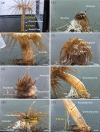A detailed observation of the ejection and retraction of defense tissue acontia in sea anemone (Exaiptasia pallida)
- PMID: 28243530
- PMCID: PMC5322752
- DOI: 10.7717/peerj.2996
A detailed observation of the ejection and retraction of defense tissue acontia in sea anemone (Exaiptasia pallida)
Abstract
Acontia, located in the gastrovascular cavity of anemone, are thread-like tissue containing numerous stinging cells which serve as a unique defense tissue against predators of the immobile acontiarian sea anemone. Although its morphology and biological functions, such as defense and digestion, have been studied, the defense behavior and the specific events of acontia ejection and retraction are unclear. The aim of this study is to observe and record the detailed process of acontia control in anemones. Observations reveal that the anemone, Exaiptasia pallida, possibly controls a network of body muscles and manipulates water pressure in the gastrovascular cavity to eject and retract acontia. Instead of resynthesizing acontia after each ejection, the retraction and reuse of acontia enables the anemone to respond quickly at any given time, thus increasing its overall survivability. Since the Exaiptasia anemone is an emerging model for coral biology, this study provides a foundation to further investigate the biophysics, neuroscience, and defense biology of this marine model organism.
Keywords: Acontia; Defense; Ejection; Exaiptasia pallida; Retraction.
Conflict of interest statement
The authors declare there are no competing interests.
Figures



Similar articles
-
Microbiome characterization of defensive tissues in the model anemone Exaiptasia diaphana.BMC Microbiol. 2021 May 21;21(1):152. doi: 10.1186/s12866-021-02211-4. BMC Microbiol. 2021. PMID: 34020587 Free PMC article.
-
Molecular tuning of sea anemone stinging.Elife. 2023 Oct 31;12:RP88900. doi: 10.7554/eLife.88900. Elife. 2023. PMID: 37906220 Free PMC article.
-
Impact of rising seawater temperature on a phagocytic cell population during V. parahaemolyticus infection in the sea anemone E. pallida.Front Immunol. 2023 Nov 22;14:1292410. doi: 10.3389/fimmu.2023.1292410. eCollection 2023. Front Immunol. 2023. PMID: 38077367 Free PMC article.
-
Sea anemone (Cnidaria, Anthozoa, Actiniaria) toxins: an overview.Mar Drugs. 2012 Aug;10(8):1812-1851. doi: 10.3390/md10081812. Epub 2012 Aug 22. Mar Drugs. 2012. PMID: 23015776 Free PMC article. Review.
-
The Tentacular Spectacular: Evolution of Regeneration in Sea Anemones.Genes (Basel). 2021 Jul 14;12(7):1072. doi: 10.3390/genes12071072. Genes (Basel). 2021. PMID: 34356088 Free PMC article. Review.
Cited by
-
Microbiome characterization of defensive tissues in the model anemone Exaiptasia diaphana.BMC Microbiol. 2021 May 21;21(1):152. doi: 10.1186/s12866-021-02211-4. BMC Microbiol. 2021. PMID: 34020587 Free PMC article.
-
Molecular tuning of sea anemone stinging.Elife. 2023 Oct 31;12:RP88900. doi: 10.7554/eLife.88900. Elife. 2023. PMID: 37906220 Free PMC article.
-
Acontia, a Specialised Defensive Structure, Has Low Venom Complexity in Calliactis polypus.Toxins (Basel). 2023 Mar 12;15(3):218. doi: 10.3390/toxins15030218. Toxins (Basel). 2023. PMID: 36977109 Free PMC article.
-
Genomic, functional and structural analyses elucidate evolutionary innovation within the sea anemone 8 toxin family.BMC Biol. 2023 May 24;21(1):121. doi: 10.1186/s12915-023-01617-y. BMC Biol. 2023. PMID: 37226201 Free PMC article.
-
Spatial metabolomics for symbiotic marine invertebrates.Life Sci Alliance. 2023 May 18;6(8):e202301900. doi: 10.26508/lsa.202301900. Print 2023 Aug. Life Sci Alliance. 2023. PMID: 37202120 Free PMC article.
References
-
- Batham EJ, Pantin CFA. Muscular and hydrostatic action in the sea-anemone Metridium senile (L.) Journal of Experimental Biology. 1950;27:264–289. - PubMed
-
- Batham EJ, Pantin CFA, Robson EA. The nerve-net of the sea-anemone Metridium senile: the mesenteries and the column. Journal of Cell Science. 1960;3:487–510.
-
- Bernheimer AW. Cytolytic peptides of sea anemones. In: Hall S, Strichartz G, editors. Marine toxins: origin, structure and molecular pharmacology. ACS; Washington, D.C.: 1990. pp. 304–311.
-
- Blanquet R. Ionic effects on discharge of the isolated and in situ nematocysts of the sea anemone, Aiptasia pallida: a possible role of calcium. Comparative Biochemistry and Physiology. 1970;35(2):451–461. doi: 10.1016/0010-406X(70)90608-0. - DOI
LinkOut - more resources
Full Text Sources
Other Literature Sources

